In the chaotic symphony of culinary endeavors, there arises an occasional crescendo of chaos: the dreaded moment when your trusty pan transforms into a fiery inferno.
It’s a scene straight out of a kitchen nightmare, yet fear not, for amidst the smoke and sizzle lies an opportunity for culinary heroism.
When faced with the fiery fury of a pan ablaze, it’s not time to panic; it’s time to embrace the flames with knowledge, strategy, and a dash of courage. So, gather your wits and aprons, for in the following guide lies the blueprint for quenching the flames and reclaiming your kitchen with finesse and flair.
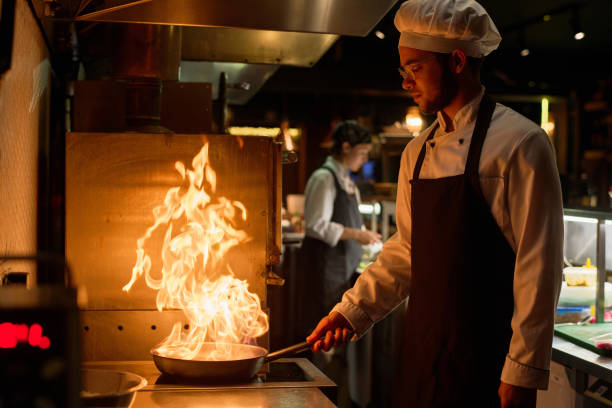
What Causes Your Pan To Catch Fire?
A pan catching fire in the kitchen is a frightening experience that can happen for several reasons. Understanding these causes can help prevent such incidents and ensure kitchen safety.
- High Heat: Excessive heat is one of the primary reasons a pan may catch fire. When cooking oil or grease reaches its smoke point, it can ignite, leading to flames. This can occur if the stove is set too high or if the oil is left unattended for too long.
- Oil Splatters: Oil splatters are common when frying or sautéing food. If these splatters come into contact with the flame on a gas stove or the heating element on an electric stove, they can ignite and cause a fire.
- Presence of Residue: Residue from previous cooking sessions, such as oil or food particles, can accumulate on the bottom of the pan. When exposed to high heat, this residue can catch fire. It’s essential to thoroughly clean pans before each use to prevent this.
- Combustible Materials: Placing flammable materials near the stove, such as paper towels, dishcloths, or even curtains, increases the risk of a fire spreading quickly if the pan ignites.
- Overheating of Non-Stick Pans: Non-stick pans can be convenient for cooking, but they can also be a fire hazard if overheated. When non-stick coatings are exposed to high temperatures, they can emit toxic fumes and even catch fire.
- Cooking Alcohol: Flambéing or adding alcohol to a hot pan can result in a sudden burst of flames. If not handled carefully, this can lead to a fire spreading beyond the pan.
- Negligence: Many kitchen fires occur due to human error, such as leaving cooking unattended or forgetting to turn off the stove. Distractions while cooking can also contribute to accidents.
7 Things To Do What To Do When Your Pan Is On Fire
When faced with a pan fire, it’s crucial to act quickly and decisively to prevent the situation from escalating. Here are seven essential steps to take when your pan is on fire:
1. First, Turn Off The Heat
Absolutely, turning off the heat is the first and most critical step when dealing with a pan fire. By cutting off the heat source, you immediately stop the fire’s fuel supply, which is essential for preventing it from spreading further.
Quickly locate the burner knob or dial and turn it off. Ensure you turn off the correct burner if you have multiple pots or pans on the stove.
This immediate action helps contain the fire and is the first line of defense in managing the situation. Remember, always prioritize your safety and that of others in the vicinity while taking this action.
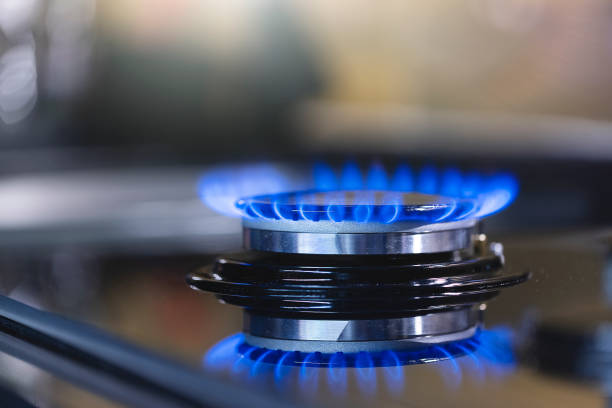
2. Immediately Cover The Pot
Covering the pot or pan is the next crucial step after turning off the heat when dealing with a pan fire. By covering the pot with a tight-fitting lid, you effectively cut off the oxygen supply to the flames, which is necessary for combustion.
This action helps smother the fire and prevent it from spreading further. When covering the pot, use a metal lid if available, as it can withstand high temperatures without melting. Carefully place the lid over the pot, ensuring it completely seals the opening to suffocate the flames.
Avoid using glass lids, as they may shatter due to the intense heat of the fire. By promptly covering the pot, you contain the fire and reduce the risk of it spreading to other surfaces or causing more significant damage.
3. Spread A Significant Amount Of Baking Soda
Spreading a significant amount of baking soda over the pan fire is another effective method to extinguish the flames. Baking soda, also known as sodium bicarbonate, is a chemical compound that releases carbon dioxide when heated, smothering the fire by displacing oxygen.
It’s important to note that baking soda should only be used on small fires and should not be relied upon for larger or more severe fires. To apply baking soda, carefully grab a container of baking soda and pour it generously over the flames.
Use a large amount to ensure thorough coverage of the fire. Be cautious not to get too close to the flames to avoid injury. Once applied, the baking soda should smother the fire, extinguishing it within moments.
After the fire is out, carefully monitor the pan and surrounding area for any signs of reignition. Always prioritize safety and evacuate the area if the fire cannot be controlled or if it poses a threat to your well-being.
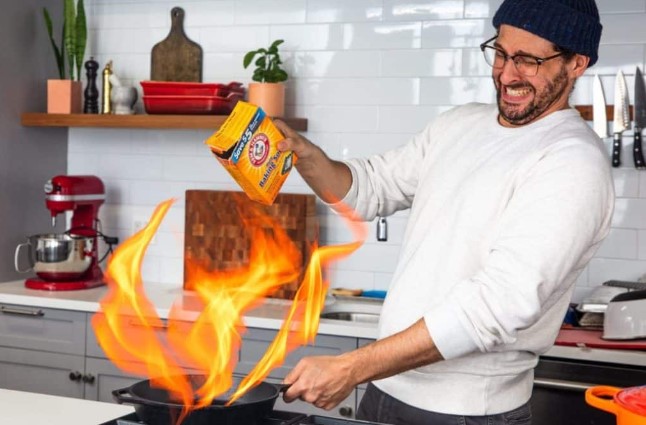
4. Shower With Salt
While baking soda is commonly used to extinguish small fires, salt can also be effective due to its ability to smother flames by cutting off the oxygen supply.
However, using salt to extinguish a pan fire might not be the most practical method, especially if dealing with a larger or more intense fire.
Nevertheless, if you don’t have baking soda readily available, and the fire is relatively small and contained within the pan, you can attempt to extinguish it by showering it with salt. Grab a container of salt and pour a generous amount directly onto the flames, covering them entirely.
The salt will help smother the fire by cutting off the oxygen supply, eventually extinguishing it. It’s essential to remember that salt might not be as effective as baking soda in some cases, so if the fire persists or grows, evacuate the area immediately and call emergency services. Safety should always be the top priority when dealing with fires.
5. Ensure That You Have A Fire Extinguisher
Having a fire extinguisher readily available is a crucial safety measure in any kitchen. Before attempting to cook, it’s essential to ensure that you have a fully functional fire extinguisher within easy reach. In the event of a pan fire or any other type of kitchen fire, a fire extinguisher can be instrumental in quickly suppressing the flames and preventing the situation from escalating.
To ensure preparedness:
- Choose the right type of fire extinguisher: For kitchen fires involving grease or cooking oils, it’s recommended to use a Class K fire extinguisher specifically designed for combating kitchen fires. Class K extinguishers contain a special extinguishing agent that effectively smothers grease fires.
- Check the expiration date: Fire extinguishers have expiration dates and should be replaced or serviced as needed to ensure they are fully functional when needed.
- Familiarize yourself with its operation: Before an emergency arises, take the time to familiarize yourself with how to operate the fire extinguisher properly. Read the instructions and become comfortable with using it.
- Keep it accessible: Store the fire extinguisher in an easily accessible location in the kitchen, away from potential fire hazards but within reach in case of emergency.
Having a fire extinguisher on hand provides an added layer of protection and can help you quickly and effectively respond to a pan fire or any other unexpected fire in the kitchen. Remember, safety always comes first, so if you’re unsure about how to use a fire extinguisher or if the fire is too large to handle, evacuate the area immediately and call emergency services for assistance.
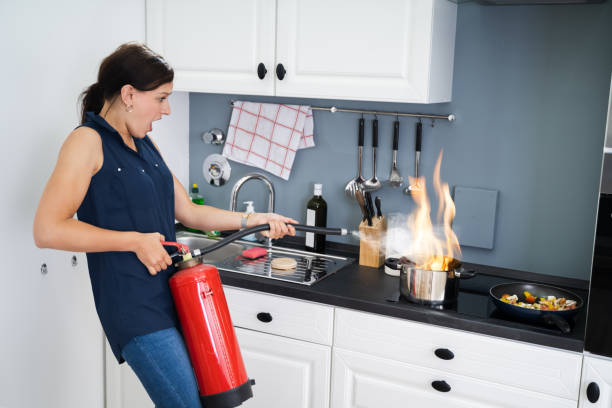
6. Make Use Of A Thick Cloth
Using a thick cloth can be a valuable tool when dealing with a pan fire, especially if other extinguishing methods are not readily available.
While it may not be as effective as a fire extinguisher or covering the pan with a lid, a thick cloth can still help smother small flames and reduce oxygen flow to the fire. To utilize this method, quickly grab a thick, damp cloth or towel and carefully approach the burning pan.
Use the cloth to cover the flames by placing it gently over the top of the pan. Ensure the cloth completely covers the opening of the pan to effectively block oxygen and suffocate the fire.
Remember to use caution to avoid burns, and if the fire continues to burn or grows despite your efforts, prioritize safety and evacuate the area immediately, then call emergency services.
While using a thick cloth may not always be the most effective method, it can serve as a temporary solution to contain a small pan fire until more suitable extinguishing methods can be implemented.
7. Call The Emergency Hotline
If you are unable to control the pan fire using the aforementioned methods or if the fire continues to grow despite your efforts, calling the emergency hotline is imperative. In many countries, the emergency hotline is 911, but it may vary depending on your location.
Promptly dialing the emergency hotline ensures that professional help is on the way, and trained firefighters will arrive to extinguish the fire safely and efficiently. Provide the dispatcher with accurate information about the situation, including your location and the nature of the fire, to ensure a swift response.
If necessary, evacuate the area and ensure everyone’s safety while awaiting the arrival of emergency services. Remember, it’s always better to err on the side of caution and seek professional assistance rather than attempting to tackle a fire beyond your control.
By calling the emergency hotline, you’re taking proactive steps to ensure the safety of yourself, your loved ones, and your property.
4 Things Not To Do When Your Pan Is On Fire

When dealing with a pan fire, it’s crucial to know what not to do to avoid exacerbating the situation and risking harm to yourself or others. Here are four things to avoid when your pan is on fire:
1. Do Not Use Water
Absolutely, using water to extinguish a grease fire is one of the most critical things not to do when your pan is on fire. Pouring water onto a grease fire can cause the hot oil to splatter, spreading the flames and potentially causing severe burns or injuries.
Water can sink to the bottom of the pan, where it quickly turns into steam and expands, causing the flaming grease to spew out of the pan and spread the fire further. This can lead to a much larger and more dangerous fire.
Therefore, it’s essential to avoid using water and opt for safer methods, such as covering the pan with a lid or using a fire extinguisher specifically designed for grease fires. By avoiding the use of water, you can prevent the situation from escalating and minimize the risk of harm to yourself and others.
2. Do Not Move the Pan
Another crucial action to avoid when dealing with a pan fire is moving the pan. Attempting to move the pan while it is on fire can be extremely dangerous and may lead to the fire spreading or causing burns.
Moving the pan can cause flaming grease or oil to spill onto surrounding surfaces, such as countertops or floors, potentially igniting additional fires. Moreover, the act of moving a hot pan can increase the risk of burns to yourself or others nearby.
It’s essential to leave the pan in place and focus on extinguishing the fire using safe methods such as covering it with a lid or using a fire extinguisher. By avoiding the temptation to move the pan, you can prevent the fire from spreading and minimize the risk of injury or further damage to your kitchen and home.
3. Do Not Use Flour or Sugar
Another critical action to avoid when dealing with a pan fire is using flour or sugar to try to extinguish the flames. While it may seem intuitive to use these common kitchen ingredients to smother a fire, they can actually exacerbate the situation.
When exposed to high heat, flour and sugar can ignite and cause the fire to spread further. The fine particles of flour or sugar can quickly disperse in the air, potentially igniting and creating a flash fire.
Therefore, it’s essential to resist the urge to use flour or sugar and instead focus on safer methods such as covering the pan with a lid or using a fire extinguisher specifically designed for grease fires. By avoiding the use of flour or sugar, you can prevent the fire from escalating and minimize the risk of harm to yourself and others.
4. Do Not Ignore the Fire
One of the most dangerous things to do when your pan is on fire is to ignore it. Ignoring a fire, even if it seems small at first, can allow it to rapidly escalate into a much larger and more dangerous situation. Fires can quickly spread, especially when fueled by hot oil or grease, and pose a significant threat to life and property.
Ignoring a pan fire can lead to severe consequences, including:
- Rapid spreading: Pan fires can quickly spread to nearby surfaces, such as cabinets, curtains, or walls, igniting a larger area and making it more challenging to control.
- Toxic smoke: Ignoring a fire allows it to produce more smoke, which can fill the kitchen and surrounding areas with toxic fumes, posing a serious health hazard to anyone nearby.
- Structural damage: Unchecked fires can cause extensive damage to your kitchen and home, including structural damage from flames, heat, and smoke.
- Injury or death: Ignoring a fire increases the risk of injury or death to yourself, your family, and anyone else in the vicinity. Fires can cause severe burns, smoke inhalation, and other injuries, and can even be fatal if not promptly addressed.
Therefore, it’s essential never to ignore a pan fire, no matter how small it may seem. Instead, take immediate action to extinguish the fire or evacuate the area and call emergency services for assistance. By addressing the fire promptly, you can prevent it from escalating and protect yourself and your loved ones from harm.
6 Different Types Of Fire Extinguishers
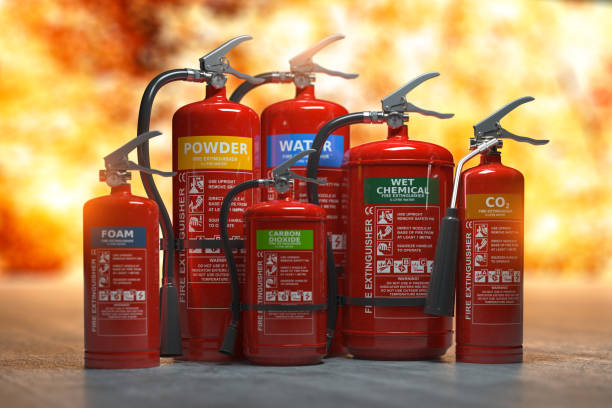
There are several different types of fire extinguishers, each designed to combat specific types of fires. Here are six different types of fire extinguishers:
Water and Foam (Class A)
- Water and foam fire extinguishers are designed to combat Class A fires, which involve common combustible materials such as wood, paper, fabric, and plastics.
- They work by cooling the flames and creating a barrier between the fuel and the oxygen, effectively extinguishing the fire.
- Water and foam extinguishers are non-conductive and leave no residue, making them suitable for use in environments where electrical equipment is present.
- It’s important to note that water and foam extinguishers should not be used on Class B (flammable liquids) or Class C (electrical) fires, as they can exacerbate the situation and pose additional risks.
Carbon Dioxide (CO2) (Class B and C)
- Carbon dioxide (CO2) fire extinguishers are designed to combat Class B (flammable liquids) and Class C (electrical) fires.
- They work by displacing oxygen, smothering the fire and interrupting the chemical reaction without leaving any residue.
- CO2 extinguishers are non-conductive, making them safe for use on electrical fires, but they do not provide any post-fire protection against reignition.
- It’s important to ensure proper ventilation when using CO2 extinguishers, as the gas can displace oxygen in confined spaces, posing a risk to individuals in the vicinity.
Dry Chemical (Class A, B, and C)
- Dry chemical fire extinguishers are versatile and can be used on Class A (common combustibles), Class B (flammable liquids), and Class C (electrical) fires.
- They contain a fine powder that interrupts the chemical reaction of the fire and forms a barrier to prevent reignition.
- Dry chemical extinguishers are effective in quickly suppressing fires, but they can leave a residue that may be corrosive and require cleanup.
- While suitable for a variety of fire types, it’s essential to ensure proper training in the use of dry chemical extinguishers, as they may not be as effective or appropriate for certain types of fires, such as deep-seated Class A fires.
Wet Chemical (Class K)
- Wet chemical fire extinguishers are specifically designed for Class K fires, which involve cooking oils and fats commonly found in commercial kitchens.
- They work by creating a foam blanket that suppresses the flames and cools the oil to prevent reignition.
- Wet chemical extinguishers are highly effective in quickly extinguishing Class K fires and are designed to safely handle the unique challenges posed by cooking oil fires.
- It’s essential to have wet chemical extinguishers installed in commercial kitchens where the risk of Class K fires is higher, and proper training in their use is crucial to ensure effective response in the event of a fire emergency.
Clean Agent (Class B and C)
- Clean agent fire extinguishers are suitable for use on Class B (flammable liquids) and Class C (electrical) fires.
- They contain non-conductive, volatile gases that extinguish the fire by removing heat and interrupting the chemical reaction.
- Clean agent extinguishers leave no residue, making them ideal for sensitive electronic equipment and other valuable assets.
- It’s important to ensure proper ventilation when using clean agent extinguishers, as the gases can displace oxygen in confined spaces, posing a risk to individuals in the vicinity. Additionally, clean agent extinguishers should be handled and maintained according to manufacturer specifications to ensure effectiveness in an emergency.
Water Mist (Class A and C)
- Water mist fire extinguishers are versatile and can be used on Class A (common combustibles) and Class C (electrical) fires.
- They work by discharging microscopic water droplets, which cool the fire and displace oxygen, effectively extinguishing the flames.
- Water mist extinguishers are safe for use on live electrical equipment, as they do not conduct electricity and pose minimal risk of electrical shock.
- Due to their effectiveness and safety, water mist extinguishers are suitable for a wide range of environments, including offices, homes, and industrial settings, where the risk of Class A and C fires may be present.
5 Different Classes Of Fire
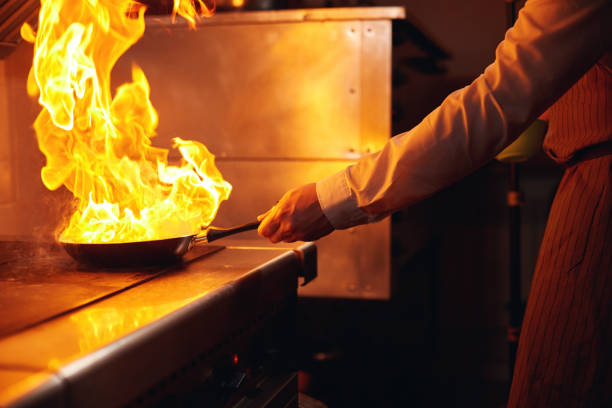
There are five different classes of fire, each classified based on the type of fuel involved. Here they are:
Class A – Ordinary Combustibles
Class A fires involve ordinary combustible materials such as wood, paper, fabric, and plastics. These fires are typically fueled by solid materials that leave behind ash after burning. Examples of Class A fires include:
- Fires involving wood furniture, lumber, or structural materials
- Paper fires, including documents, cardboard, and books
- Fabric fires, such as those involving clothing, curtains, or upholstery
- Plastic fires, including household items like toys, containers, and appliances
Class A fires can occur in various settings, including homes, offices, warehouses, and industrial facilities. They are generally extinguished using water or foam-based extinguishing agents, which cool the flames and smother the fire by removing heat and oxygen.
It’s important to note that using water on electrical fires or fires involving flammable liquids can be ineffective or dangerous, so it’s essential to assess the situation carefully and use the appropriate extinguishing method.
Class B – Flammable Liquids
Class B fires involve flammable liquids such as gasoline, oil, grease, solvents, and other liquid-based fuels. These fires are characterized by their rapid spread and the potential for explosive combustion. Examples of Class B fires include:
- Fires involving gasoline spills at gas stations or automobile accidents
- Oil or grease fires in kitchens or industrial settings
- Solvent fires in laboratories or manufacturing facilities
- Flammable liquid spills or leaks in storage areas or transportation vehicles
Class B fires can be extremely dangerous due to the volatile nature of the fuels involved. They can spread quickly, producing intense heat and dense smoke.
To extinguish Class B fires, specialized fire extinguishers containing dry chemical, foam, or carbon dioxide (CO2) agents are typically used. These agents work by smothering the fire, removing heat, or interrupting the chemical reaction.
It’s important to avoid using water on Class B fires, as it can cause the flames to spread or the liquid fuel to splash, resulting in more extensive damage and increased risk of injury.
Class C – Electrical Equipment
Class C fires involve energized electrical equipment such as appliances, wiring, circuit breakers, and outlets. These fires are unique because they occur in the presence of live electrical currents, which can pose additional hazards to individuals attempting to extinguish them. Examples of Class C fires include:
- Electrical fires involving overloaded outlets or faulty wiring in homes or commercial buildings
- Fires sparked by malfunctioning electrical appliances such as toasters, microwaves, or space heaters
- Electrical fires in industrial settings, including those involving machinery, control panels, or electrical panels
Class C fires can be challenging to extinguish because simply cutting off the power source does not eliminate the risk of the fire reigniting. Using water or conductive extinguishing agents on Class C fires can also pose a risk of electrical shock to firefighters and bystanders.
Therefore, carbon dioxide (CO2) or dry chemical extinguishers are commonly used to suppress Class C fires. These agents smother the flames and deprive the fire of oxygen without conducting electricity, making them safe for use on live electrical equipment.
Additionally, it’s essential to de-energize the electrical equipment whenever possible and evacuate the area if the fire cannot be safely controlled.
Class D – Combustible Metals
Class D fires involve combustible metals, which are highly reactive and can burn at extremely high temperatures. These fires are rare but can occur in industrial settings where combustible metals are present.
Examples of combustible metals include magnesium, titanium, potassium, sodium, and lithium. Class D fires are characterized by intense, dazzling white flames and the release of heat and flammable gases.
Examples of Class D fires include:
- Fires involving magnesium or aluminum shavings in machining operations
- Fires in chemical manufacturing facilities where reactive metals are handled
- Fires in laboratories where combustible metal powders are used or stored
- Fires involving metal dust or chips in metalworking processes
Class D fires require specialized extinguishing agents designed to react with the metal and deprive it of oxygen. Water, foam, and carbon dioxide extinguishers are ineffective and can even exacerbate Class D fires by spreading the burning metal.
Instead, Class D fires are typically extinguished using dry powder extinguishing agents specifically formulated for metal fires. These agents form a crust over the burning metal, cutting off the oxygen supply and preventing further combustion.
It’s essential to evacuate the area and call for specialized assistance when dealing with Class D fires due to their unique hazards and challenges.
Class K – Cooking Oils and Fats
Class K fires involve cooking oils and fats commonly found in commercial kitchens, such as vegetable oils, animal fats, and grease. These fires are distinct from other types of fires due to the high temperatures at which cooking oils and fats ignite and the potential for re-ignition even after the flames have been extinguished. Examples of Class K fires include:
- Fires in restaurant kitchens involving deep fryers or cooking equipment
- Fires on stovetops caused by overheated cooking oil or grease
- Fires in industrial food processing facilities where cooking oils and fats are used in large quantities
- Fires in residential kitchens resulting from unattended cooking or grease buildup on cooking surfaces
Class K fires can be challenging to extinguish using traditional fire extinguishing agents, as water can cause the hot cooking oil to splatter and spread the fire further.
Instead, wet chemical extinguishers specifically designed for Class K fires are used to suppress these fires effectively. Wet chemical agents react with the cooking oil, creating a foam blanket that cools the oil and prevents re-ignition.
It’s crucial to have Class K fire extinguishers installed in commercial kitchens where the risk of cooking oil fires is higher, and proper training in their use is essential to ensure effective response in the event of a fire emergency.
Frequently Asked Questions (FAQs) – What To Do When Your Pan Is On Fire
What should I do if my pan catches fire unexpectedly?
Remain calm and focused. Your first step is crucial for safety.
How can I safely extinguish a pan fire without causing harm?
The key is to act swiftly yet cautiously. We’ll guide you through effective methods.
Is it safe to use water to extinguish a pan fire?
While water can exacerbate grease fires, there are safer alternatives we recommend.
What are the best techniques for handling a grease fire in a pan?
We’ll walk you through simple yet effective strategies to swiftly tackle the situation.
Should I attempt to move a burning pan?
Safety is paramount. Discover when and how to safely relocate a flaming pan.
How can I prevent pan fires in the future?
Proactive measures are key. Explore practical tips to minimize the risk of fires in your kitchen.
Are there any warning signs I should watch for to prevent pan fires?
Stay vigilant. Learn to recognize early indicators and take preemptive action.
What should I do if I’m unsure about handling a pan fire?
Your safety is our priority. We’ll provide guidance and resources to assist you in any situation.
Can I use a fire extinguisher to put out a pan fire?
We’ll discuss the appropriate use of fire extinguishers and when they’re suitable for pan fires.
What should I do after successfully extinguishing a pan fire?
Even after the fire is out, there are important steps to follow to ensure ongoing safety and peace of mind.
Conclusion
In conclusion, when faced with the alarming situation of a pan fire, swift and decisive action is paramount to ensuring both personal safety and property preservation.
By adhering to the essential steps outlined – remaining calm, turning off the heat source, covering the flames with a lid, and utilizing a fire extinguisher if necessary – individuals can effectively mitigate the risk of escalating the fire.
Moreover, proactive measures such as practicing proper cooking techniques, maintaining a clean cooking environment, and having readily accessible firefighting equipment can significantly reduce the likelihood of such emergencies occurring.
Ultimately, being prepared and knowledgeable empowers individuals to confidently handle pan fires, safeguarding themselves and their surroundings from potential harm.